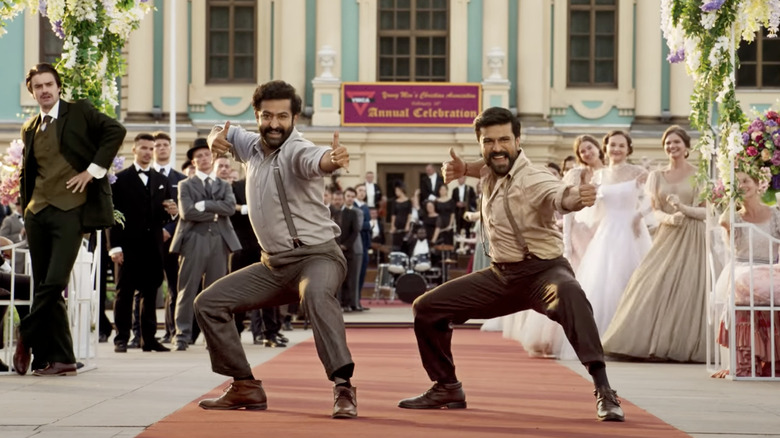
Did you think we were done talking about the greatness and glory that is "RRR" from the legendary Indian director S.S. Rajamouli? Trick question — we will never be done talking about "RRR." As the end of the year gets closer and awards season contention debates begin spurring, film fanatics are desperate to see if The Academy of Motion Pictures Arts and Sciences will do the right thing by giving "RRR" as many nominations as they can. "RRR" is rightfully deserving of its accolades and rabid word of mouth because the film is filled with moments that have to be seen to be believed.
There's an animal fight, underground running, a face-to-face battle with a tiger, a train explosion, heartbreaking flashbacks, unbelievable fight choreography, and quite possibly one of cinema's best musical dance sequences. The song "Naatu Naatu" was composed by M.M. Keeravani with lyrics by Chandrabose and it is performed by Rahul Sipligunj and Kaala Bhairava. The song appears in a pivotal moment in "RRR" when Alluri Sitarama Raju (Ram Charan) and Komaram Bheem (N. T. Rama Rao Jr.) sing the lyrics and out-dance wealthy British colonialists during a fancy party. Ram and Bheem inspire a dance battle throughout the shindig, which concludes with the duo facing off against one another.
Choreographed by the prolific Prem Rakshith, the "Naatu Naatu" dance has inspired viral TikTok dance challenges across the globe, and audience participation during theatrical screenings. Not since "The Time Warp" from "The Rocky Horror Picture Show" has a cinematic dance craze swept the globe, and it's because the choreography of "Naatu Naatu" is perfect by design. By marrying dance history, foundational Indian theatre expressions, the vibrancy of Tollywood, and an easy-to-learn hook step, the "Naatu Naatu" dance was destined for success.
The Dance Is Period Appropriate
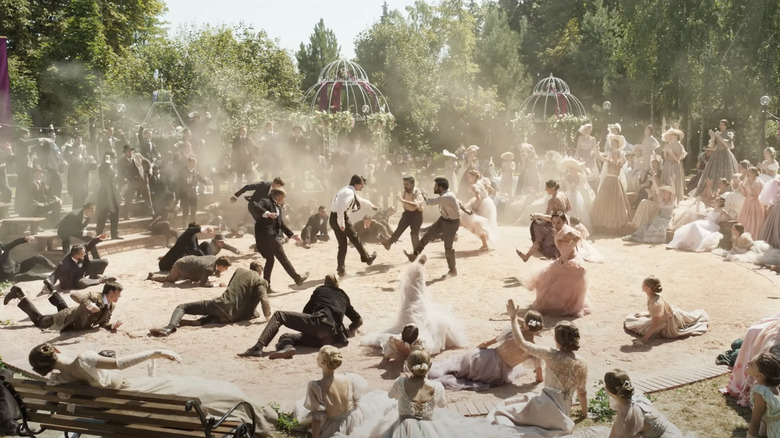
"RRR" takes place in 1920 during the British Raj, which was also a bountiful time for the proliferation of dances. The West was in the middle of "the Flapper craze," which also brought along the appropriation of popular Black dances like the "Charleston." Considering just about every viral TikTok dance trend was stolen from Black creators and popularized by white people, not much has changed. With dancing taking the world by storm, endurance competitions and marathons become commonplace, much like the dance-off shown during "Naatu Naatu" in "RRR."
Photographs from dance competitions in the United States and the UK show participants fainting, ambulances on site for exhaustion, and rumors of people literally dancing themselves to death. As silly as it may seem for current audiences to see a "spontaneous dance-off" in the middle of "RRR," the scene is actually rooted in historical accuracy. Of course, the film itself is a work of historical fiction, but these dance-offs were fairly common. Even today, each August 14, Pakistan celebrates its Independence Day with a ceremonial dance-off at the border of India.
These dance-off competitions were revered with respect and machismo, as it was seen as dominant to be able to out-dance your fellow man. There have been plenty of people who see the "Naatu Naatu" scene as nothing more than spectacle, but of all of the fiction presented in the film, this scene is wholly based in historical reality. To be quite honest, the lack of these endurance dance competitions in most of the films showcasing social gatherings in the 1920s is far more inaccurate.
A Modern Incorporation Of The Navarasas
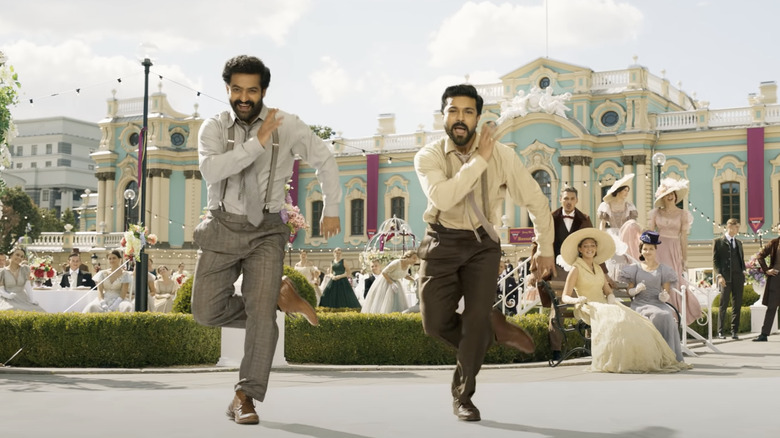
Many Western viewers of "RRR" may have found it charming to see how expressive and animated Ram Charan and N.T. Rama Rao Jr. become during "Naatu Naatu." As the two dance, lip-sync, and interact with the other characters, their faces become almost larger than life. "RRR" is littered with spectacle and intense performance, but it's usually relegated to moments of strength, power, anguish, and pain. To see the same heightened emotion during an absolutely joyous occasion is something the West doesn't see outside of, well, musicals. In India, there is a performing arts tradition of incorporating "the Navarasas," or the nine emotions evoked in an audience while watching dance, music, or acting. Not to be confused with the Netflix show of the same name, the Navarasas are an artistic expression used as a way for the performer to indicate to the audience how the character, and therefore, how they as the viewer, should be feeling about the scene at hand.
The nine emotions are Sringara Rasa (Love), Hasya Rasa (Laughter), Raudra Rasa (Anger), Karuna Rasa (Compassion), Bibhatsa Rasa (Disgust), Bhayanaka Rasa (Fear), Vira Rasa (Brave), Adbhuta Rasa (Wonder), Shanta Rasa (Peaceful). The emotions are tied to specific facial expressions, postures, and footwork, that serve as subtextual language.
The emotions function similarly to the way that we in the West have stock characters that immediately tell us how a character will likely behave. There's a reason we watch "Naatu Naatu" and can't help catching the infectious Hasya Rasa of the duo, as their faces are telling us specifically to have fun. (You can even see a moment of Bhayanaka Rasa when the two are backing away from Eduard Buhac as he screams "I've had enough!")
It Incorporates Isolations
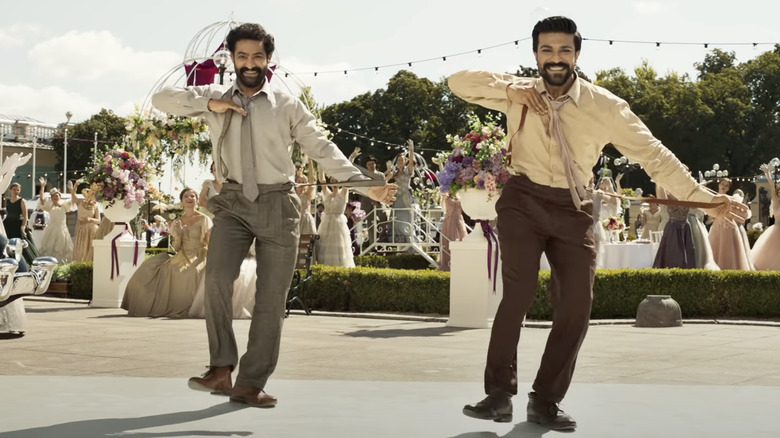
The choreography of "RRR" also incorporates isolations, most obviously shown during the "suspender section" of the dance where the arms and feet are moving, but Ram Charan and N. T. Rama Rao Jr.'s faces remain mostly unmoved. Isolations are a traditional form of Indian dance, often labeled as "Bollywood Dance," even though the practice is incorporated in Tollywood dance (which "RRR" is a part of) as well. In the West, isolations are often reserved for hip-hip dance, but isolations across the globe require a great deal of muscle control, focus, and practice. Isolations can be some of the most difficult moves to pull off, which is why "Naatu Naatu" looks effortlessly smooth, and most of us trying to do the hook step at home probably look like unbalanced elephants stomping around.
Isolations allow for dancers to have a sharper style, as the precision often allows somewhat "simple" moves to appear very impressive to onlookers. At the same time, isolations also enhance dance training in general. Because isolations, by design, force bodies into unnatural movements "that challenge the concept of traditional muscle movements," it brings an intensity to the performance. The "Naatu Naatu" choreography is smooth as hell, which is very appealing to an audience, but is not "graceful," the way something like ballet would be. The isolations in the "Naatu Naatu" choreography give the dance a fierce presentation, which makes the two men appear strong and powerful, despite the fact they're participating in an art form often viewed as "feminine."
(Side note: dance is for EVERYONE and if you think dancing is "girly," you should walk yourself to the pond for being such a silly goose before the ghost of Gene Kelly has a word with you.)
The Vibrancy Of Tollywood
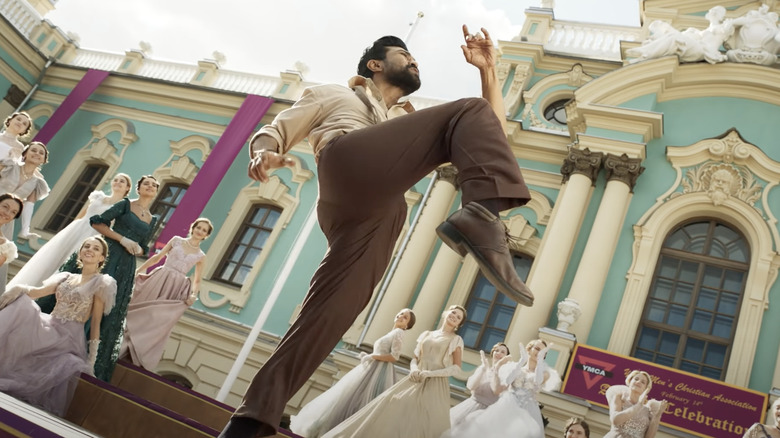
Tollywood culture is home to some of the most powerful dance traditions in global history, with ceremonial dances like the "Perini Thandavam" performed by men, and the history of warriors dancing before Lord Shiva before entering the battlefield. Dance has historically been associated with masculine power in India, which is well on display in "Naatu Naatu." At the same time, there is a traditional South Indian dance called "Burra Katha," which is a form of physical storytelling often executed by two dancers. The translation of "Naatu Naatu" as a song is essentially the instructions for how to do the dance and why the dance is fun to do — they're telling us a story with their moves.
Both Ram Charan and N.T. Rama Rao Jr. are massive Tollywood stars in their own right, but Rao Jr. is specifically hailed as one of the best dancers in the medium. He's known the world over for his fluidity and grace while executing powerful moves, and an expert combination of classical and hip-hop movements. Ram Charan comes from a family of Telugu film dancers, as his father, Chiranjeevi, was also a Tollywood actor and dancer. Charan is known for his swift and precise leg movements, which means choreographer Prem Rakshith crafted steps that work to the benefit of the stars. Classical dance, hip-hop, and precise leg movements are at the heart of "Naatu Naatu," and is a perfect showcase of the history and vibrancy of Tollywood dance.
The Hook Step
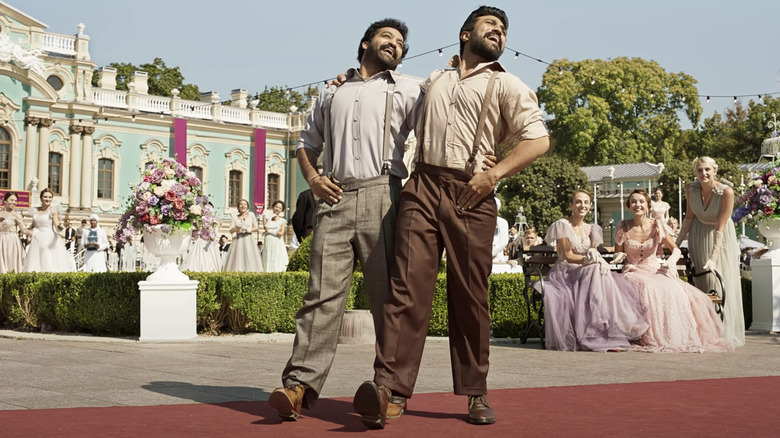
The core of "Naatu Naatu" is a hook step, and is the section of the dance that fans across the globe have been trying their hardest to learn. Prem Rakshith himself has even provided short tutorials online to help teach the step. As clever and catchy as the moves are, this was no coincidence. In recent years, filmmakers in India have specifically started incorporating hook steps into the choreography of their big dance numbers, knowing that this would provide the audience with a section of the dance to try at home, in the audience, therefore, helps spread the word of the film.
The hook step has become such a vital part of both Bollywood and Tollywood cinema, that it has completely changed the way choreographers and composers think. Even films that do not contain musical sequences are promoted with songs and dances, as it serves as a built-in marketing tool. According to Indian director N. Lingusamy, "A few decades ago, composers would specifically ask directors about which 'reel' in the film the song would be placed, and tune it accordingly. Today too, it's the Reel that decides its popularity." This is exactly why even those who haven't seen "RRR" are aware of "Naatu Naatu," with many incorrectly believing the film is just "a flashy musical," and not the mind-melting epic it actually is. The hook step sequence in "Naatu Naatu" was designed to make us all want to dance, and it worked brilliantly.
Everybody 'Naatu Naatu!'
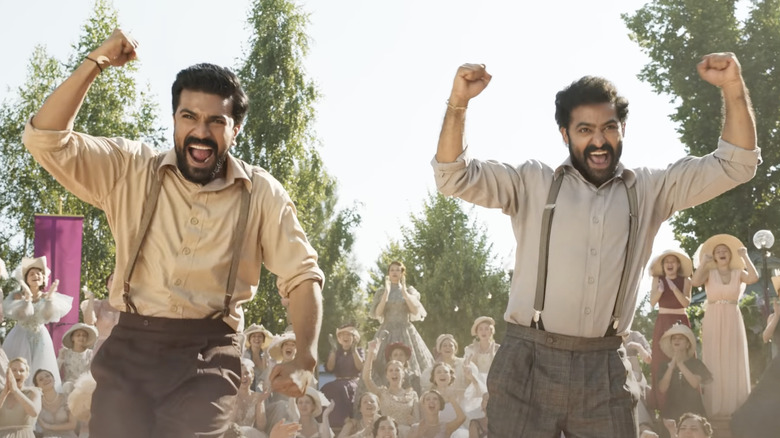
With all of these elements incorporated into the choreography, "Naatu Naatu" is an absolutely perfect dance craze. It requires more energy than the hand jive in "Grease," is easier to execute than the lift in "Dirty Dancing," has an instructional song like "The Time Warp," and has less clean-up than "Flashdance." Prem Rakshith designed a perfect dance, blending Indian history and tradition with current-era sensibilities. It's no wonder that videos of fans going wild and doing the "Naatu Naatu" in the theaters during screenings have gone viral, even if the execution of the moves are ... look, people are trying their best.
"RRR" should absolutely be represented at the Oscars this year, but if "Naatu Naatu" gets the nomination for Best Original Song, a full-scale recreation of the dance would be exactly the kind of energy the awards show needs to help its declining viewership numbers. People from all around the world would turn in to see the cast of "RRR" hook step their way to a golden statue, and it would serve as the perfect introduction for countless people to the glory of Tollywood cinema.
Read this next: The Best Movies Of 2022 So Far
The post Why the 'Naatu Naatu' Dance in RRR is More Perfect Than You Realize appeared first on /Film.
